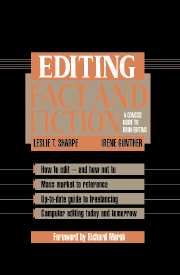Book contents
- Frontmatter
- Contents
- Foreword
- Acknowledgments
- Introduction
- Chapter 1 Who (and What) Is an Editor?
- Chapter 2 Fact or Fiction? Finding Your Niche
- Chapter 3 Principles to Edit By
- Chapter 4 The Editor's Senses
- Chapter 5 The Editor's Sensibility
- Chapter 6 A Guide to Editorial Freelancing
- Chapter 7 Electronic Editing Today and Tomorrow
- Chapter 8 Tools of the Trade and How to Use Them
- Index
Chapter 6 - A Guide to Editorial Freelancing
Published online by Cambridge University Press: 21 September 2009
- Frontmatter
- Contents
- Foreword
- Acknowledgments
- Introduction
- Chapter 1 Who (and What) Is an Editor?
- Chapter 2 Fact or Fiction? Finding Your Niche
- Chapter 3 Principles to Edit By
- Chapter 4 The Editor's Senses
- Chapter 5 The Editor's Sensibility
- Chapter 6 A Guide to Editorial Freelancing
- Chapter 7 Electronic Editing Today and Tomorrow
- Chapter 8 Tools of the Trade and How to Use Them
- Index
Summary
The book business offers a wealth of opportunities for anyone contemplating freelancing. Today's publishers farm out freelance work at virtually every stage of a book's life, beginning with the early development and shaping of the manuscript and continuing through design, editing and production, and the preparation of the index.
The “Big Three”
Freelancing's “big three”–and our main focus here–are editing, proofreading, and indexing. This is where most of the work is. All trade divisions (adult and juvenile fiction and nonfiction) use freelance copyeditors and proofreaders, as do reference publishers, textbook publishers (both college and el-hi), publishers of professional books (e.g., medical and legal books), and university presses.
Freelance editing primarily means copyediting, especially when it's for trade book houses. But like their in-house counterparts, freelance copyeditors are increasingly responsible for more than just style, grammar, and usage and some basic fact checking. A freelance assignment billed as “copyediting” may also require some line editing and even rewriting. Substantive and developmental editing are more likely to come from nontrade sources such as textbook and professional book publishers. And for freelancers who are computer literate, an editing project may include editing on screen a manuscript that was submitted on disk, electronically coding a manuscript for the typesetter, and/or electronically inserting corrections made by an in-house editor.
Proofreading is generally available from the sources that farm out copyediting (and there's usually more of it).
- Type
- Chapter
- Information
- Editing Fact and FictionA Concise Guide to Book Editing, pp. 157 - 173Publisher: Cambridge University PressPrint publication year: 1994



